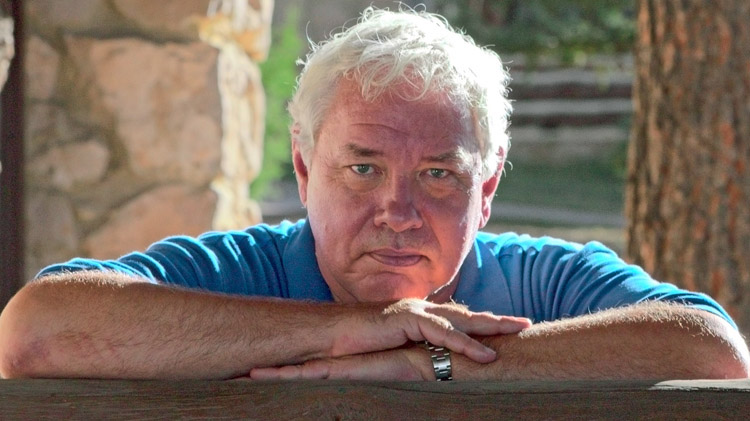Dan Margulis is internationally regarded as the most distinguished voice in the color correction and enhancement field. He is a best-selling author of books on color correction. Many of today’s leading authorities in the field have studied with him in his multiple-day small-group classes, Applied Color Theory, which have been offered in a dozen different countries and four different languages.
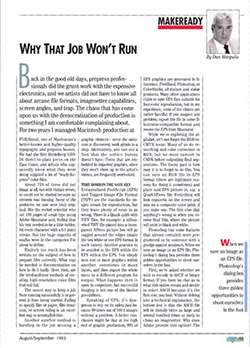
The first Makeready column, August 1993.
His professional career until 1995 was spent in prepress, first conventional and then digital when, in the 1980s, it became possible to manipulate color electronically. He was running a prepress facility in Manhattan in 1992, when on a plant visit, Frank Romano, editor of Electronic Publishing magazine, saw a piece of documentation that Margulis had written for employees, on how to trap page files properly. Romano asked permission to reprint it in the magazine.
Tom McMillan, editor of Computer Artist magazine, saw the article and proposed that Margulis write a column on desktop production for every issue, and suggested the title Makeready. As was revealed in a Makeready column reporting McMillan’s untimely death, the idea almost never got off the ground. But get off the ground it did, and it became the most influential column in graphic arts history, running worldwide, including in two magazines simultaneously in the United States, between 1993 and 2006. We have a summary of the 77 columns, and links to PDFs of many of them, here.
Ninety percent of color correction could be handled by monkeys…The rules for this ninety percent of color are so simple that they can be stated in one sentence: Use the full range of available tones every time, and don’t give the viewers anything that they will know better than to believe.
—Professional Photoshop, 1994
In 1994, Photoshop was just introducing layers, and had just begun to require that users have more than 8 megabytes of RAM. Dan celebrated the release of Photoshop 3 with his first book, Professional Photoshop. Coming at a time when almost no one had experience with serious professional use of desktop applications for imaging, the book was an immediate best-seller in spite of its high price for the time of $50.
Earlier that year, Dan opened his partnership with Ledet Training to offer a three-day, small-group color correction course, all hands-on, in Atlanta. The collaboration has continued over the years and the course, Applied Color Theory, has been offered hundreds of times. The audience has changed over the years as one industry after another has moved into this type of work.

Dan is a popular speaker in Russia. After a large Moscow session in 2003, fans gave him this traditional matryoshka nested doll.
By 1998 Photoshop was fully established as the planet’s prime color correction platform. Margulis and his publisher brought out a new edition of Professional Photoshop, with the color materials tripled in size and everything else deleted. The publication came at the same time as the release of Photoshop 5, which had many new color capabilities as well. In a fateful decision that Margulis later described as one of the worst blunders of his career, the new book was titled Professional Photoshop 5. Shortly after its publication, he and Ledet Training established an appliedcolortheory discussion list that continues to this day.
A title like that requires a new edition with each new Photoshop release. This is not so bad for typical titles, which don’t change much over time. But in each installment of the Professional Photoshop series, Margulis has rewritten well over half of the content to accommodate new techniques. Professional Photoshop 6 came out in 2000, at the same time that Adobe announced that henceforward new versions of Photoshop would be released on a speedier schedule, every eighteen months.
Author-publisher relations broke down over this development. The author was not interested in continuing to write on that schedule; he agreed that the existing title required a new edition was needed as soon as Photoshop 6 was no longer current, but he demanded that the new edition be called Professional Photoshop Fourth Edition rather than Professional Photoshop 7. The publisher strongly opposed this and relations deteriorated thereafter, with the two sides parting bitterly after the publication.
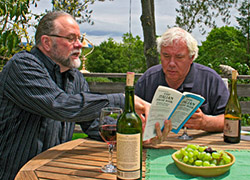
Bert Monroy and Dan Margulis prep for their forthcoming Italian tour, 2010.
Meanwhile, in 2001, Margulis received a signal honor. The National Association of Photoshop Professionals announced the formation of a Photoshop Hall of Fame. The three charter members chosen were Photoshop architect Thomas Knoll, digital artist Diane Fenster, and Dan Margulis, representing educators. Meanwhile, Margulis had begun to teach Applied Color Theory in other countries.
In 2004, with new publisher Peachpit Press, Margulis revolutionized workflows with his Photoshop LAB Color: The Canyon Conundrum and Other Adventures in the Most Powerful Colorspace. Previously, LAB had been the exclusive property of top retouchers; the new book made it accessible to everyone.
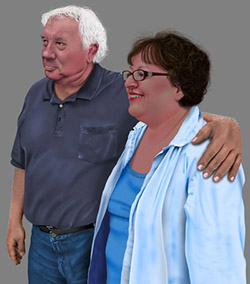
Here’s Bert’s illustration of Dan Margulis and the late Cathy Panagoulias, as appearing in his mammoth Times Square digital painting
Professional Photoshop Fifth Edition, which Margulis identified in the Introduction as being the final installment in the series, appeared in 2005. Shortly thereafter, he announced that the Makeready column, which was then appearing in two U.S. magazines and in half a dozen other countries in translation, would also be wound down.
At about this time, Margulis began to consider a radical new workflow based on complete separation of color and contrast; traditional practice is to manage them together. He unveiled it in April 2007, at a presentation to MIT graduate students and faculty. The reaction was positive enough that a few days later, he cancelled a scheduled session at the Photoshop World conference and substituted a discussion of what he called, for the first time, a “Picture Postcard Workflow” that stressed speed.
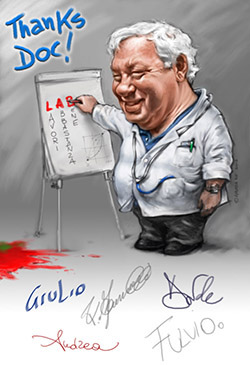
An Italian class in 2012 gave this sketch to Dan. The red stain on the floor refers to the sessions where Dan compares the results that each student has gotten on a certain image; this session is known in English as the evaluation. Italian students usually call it il bagno di sangue, or “the bloodbath.”
The basic principles of the workflow stayed the same over the years but many changes and refinements were introduced. In 2009, Margulis recorded more than six hours of videos, describing the workflow for Kelby Training, where they are still available. At about the same time, the Applied Color Theory course was revamped to emphasize the new workflow. And, in a development that would prove to be of significance, one of the first places he taught it was Italy, where the students included several of his current collaborators.
The PPW is amenable to automation, as many of its steps repeat from image to image. Margulis used a set of Photoshop actions in his classes in 2009, updating them when needed. The following year, he began to assemble the actions into a simple panel for easy access, using Adobe’s Configurator module. A team of his Italian friends decided to invest substantial time in adding scripting features to it to allow more user options, and introduced many other improvements. Version 3 of this PPW panel was released simultaneously with the publication of Modern Photoshop Color Workflow. It was updated several times since then until reaching the end of its development in the pandemic years. It still can be installed with some difficulty. In 2015 came the second edition of Photoshop LAB Color, with around three-quarters new content. And in 2020 came the culmination of several years of work, a new, completely rewritten version of M.E. Chevreul’s 1839 classic guide to color usage, On the Law of Simultaneous Contrast of Colors. In addition to Chevreul’s text, appropriately annotated, there are six chapters and hundreds of graphics added by Dan.
Margulis was the 2023 recipient of the Progress Award, the highest honor given by the Photographic Society of America. Among previous recipients are Ansel Adams, Tim Berners-Lee, Ken Burns, Jacques-Yves Cousteau, Walt Disney, Alfred Eisenstaedt, Adolf Fassbender, Victor Hasselblad, Edwin Land, Frans Lanting, and Henry Luce.
The group cited him “For the authoritative work in the field of digital color correction of photographs. Establishing the usage of L*A*B* as a standard part of the repertory of high-end retouchers. Teaching that digital color correction should seek to correspond to what a human observer would see if placed in the position on the camera. Publishing techniques to emulate certain well-known reactions/attributes of the human visual system, such as chromatic adaptation and simultaneous contrast.”


